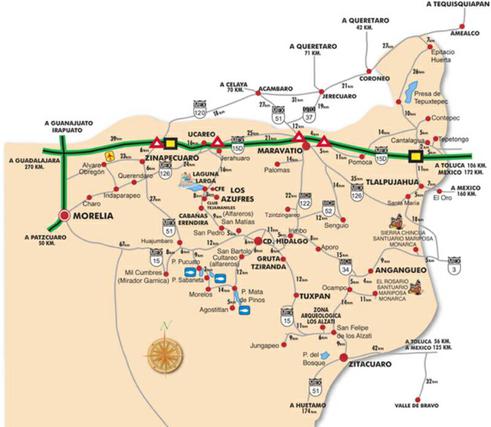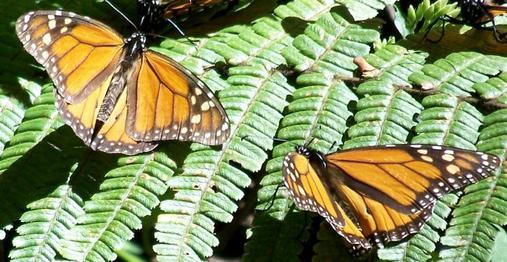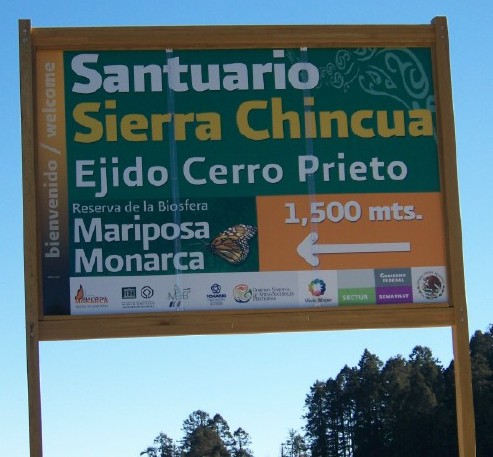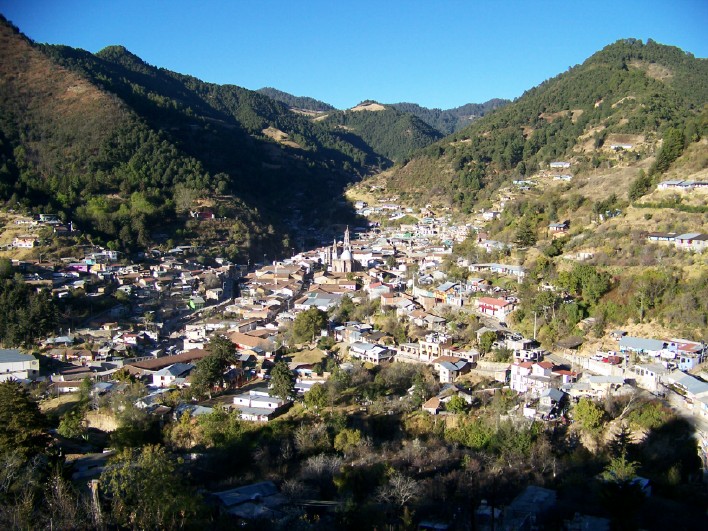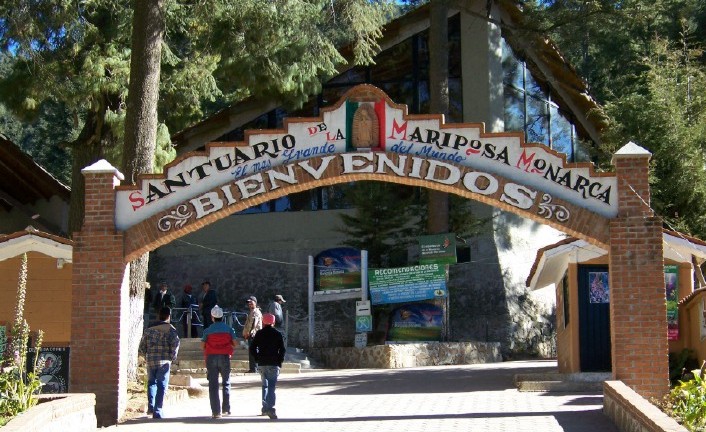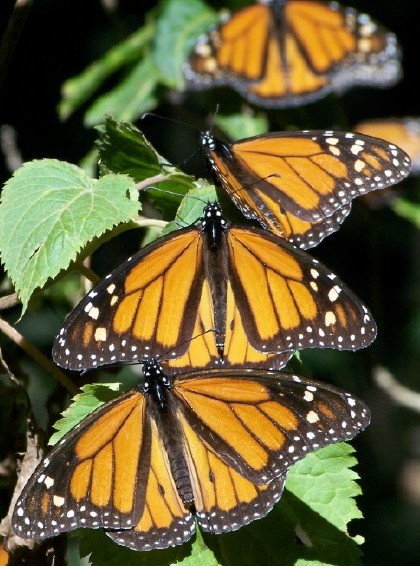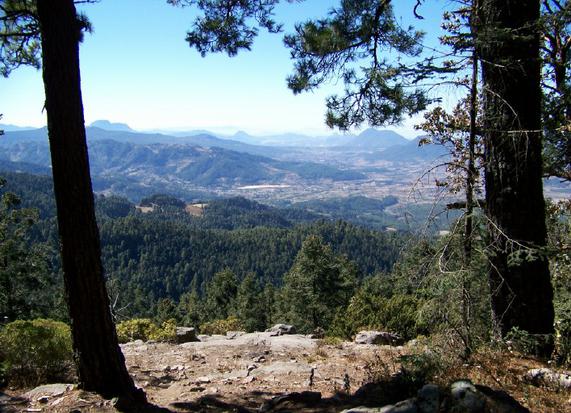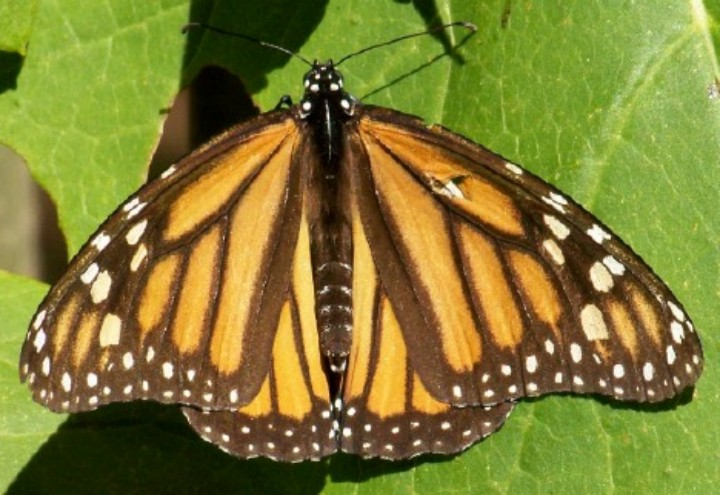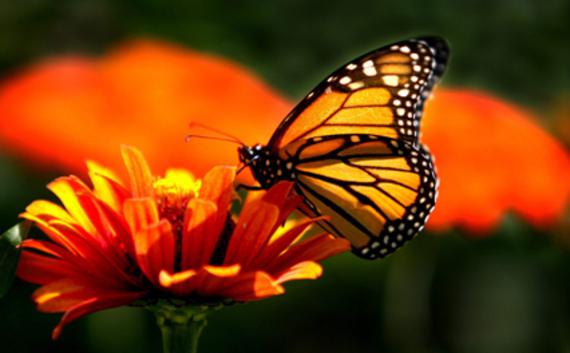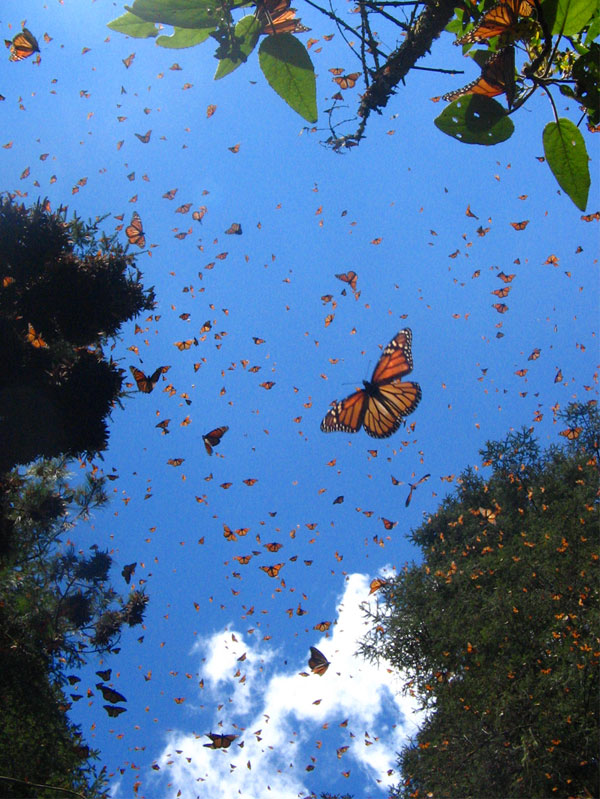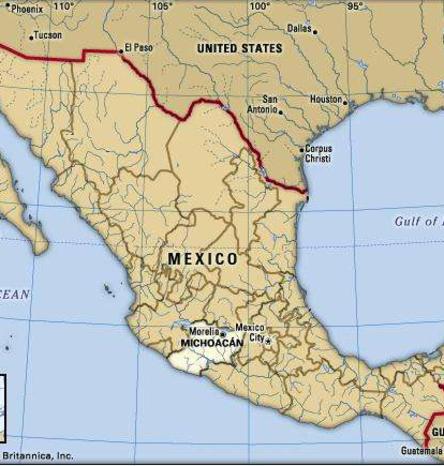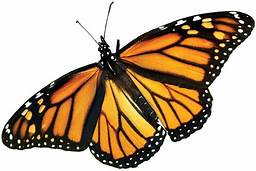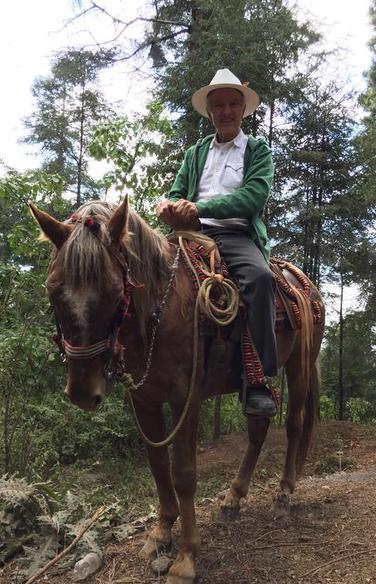This page was last updated: September 19, 2025
 | ||||||
Monarch Butterflies
 | ||||||
This is the official website of the Sanctuaries.
The Erendira's Cabins and Bathing Resort is located a few kilometers from the Monarch Butterflies Sanctuaries where the Monarch gathers in colonies that sometimes reach over 20 million after travelling more than 5000 Kilometers from Canada during November through March.
Cabañas y Balneario Erendira
Kilómetro 14 carretera
Los Azufres, Michoacan, Mexico.
Mailing Address:
At'n: Cabañas y Balneario Erendira
Avenida Morelos No. 43
C.P. 61100
Ciudad Hidalgo Michoacan, Mexico.
Reservations
Tel: +52 (786) 1 54 01 69
(Daily from 09:00 to 15:00 hrs. except Wednesday)
Fax: +52 (786) 1 54 52 69
 | ||||||
Spectacular hikes, monarchs in Mexican mountains
·
CERRO PRIETO, Mexico (AP) --
The Biosphere Reserve, a federally protected area nominated for World Heritage Site status, spans some 124,000 acres across two states and guided tours are available. In some parts, visitors can trek about on rented horses and burros.
Mexican President Felipe Calderon plans to pump an extra $4.6 million into the reserve's $36.4 million budget this year, to improve infrastructure and make the area more tourist-friendly.
Astrid Fisch, director of operations for Ecotours de Mexico, an environmentally conscious travel agency based in Puerto Vallarta, said she tells foreign clients to go on weekdays to avoid throngs of Mexican tourists. Be prepared to hike anywhere from 20 minutes to over an hour or to ride a donkey. You can only reach the butterflies on paths laid by the reserve, and they congregate at extremely high altitudes -- between 9,000 and 11,000 feet -- so visitors should be in good enough physical condition to handle steep inclines.
If You Go:
GETTING THERE: Visitors can fly to the Toluca, Morelia or Mexico City airports and then rent a car or hop a bus to the town of Angangueo or the city of Zitacuaro -- both of which offer lodging and transportation, usually buses or taxis, to the butterfly reserve.
ANGANGUEO:
FOOD: Bringing food into the reserve is prohibited, so plan on staying for a few hours and then heading back down to the entrance to enjoy quesadillas or tostadas at stands that cluster there.
WHAT TO WEAR: Because weather can be extremely cold in the morning, dress in warm, layered clothing that can be easily shed, and wear comfortable hiking boots. A raincoat might also be a good idea, since mist and light rains are common.
WHEN TO GO: The butterflies begin arriving in November, and leave by late March. The best time to see them is between 10:30 a.m. and 1 p.m., when they are at their most active.
TIP: On cloudy days, the butterflies remain still to preserve body heat. It's advisable to plan your trip to include an overnight stay in the area so you can come back on a different day if the weather doesn't cooperate.
OTHER ATTRACTIONS: Morelia is a beautiful, colonial city with great food and arts and crafts; Patzcuaro, a tiny village on a breathtaking lake, has a great food and crafts market and two lovely plazas and is known for its Day of the Dead celebration in early November; Tlalpujahua is a tiny, picturesque town, an ideal place to stop for lunch.
ECOTOURS DE MEXICO: www.ecotoursvallarta.com or call 011-52-322-222-6606 (from USA) CNN.com /travel
X Lake Patzcuaro
Butterfly
<===
Area
A friend from San Miguel de Allende wrote about visiting the butterflies:
There really is no need for a tour guide unless you don't speak any Spanish. The signs in the park explain about the butterflies are all in Spanish, not English.
Make sure you bring layered clothes and good hiking shoes. Try to get for sunrise, but for sure before noon. The walk up, including passing by the food and artisan stalls, takes a leisurely 3 hours. If it is cloudy, it might be cool, and it will be hot in the sun. Bring water with you, they charge a premium for it at the site. From the parking lot you will go up a trail lined with vendors. It can be very smokey from the cooking grills.
You will start to see butterflies from the beginning. You make your way up to the visitor center, and from there, it is about a one hour hike mostly uphill. You will be in the shade of the oyamel fir trees, some parts with steps, others just dusty soil, up to where the butterflies are hanging out. There are swarms of Monarch overhead and all around, getting thicker the further into the oyamel forest you go. It is a moderately strenuous hike, so take it slow with breaks if you are not in the best of shape. We saw many old grandmothers up there, and some were hard to keep up with! Most shouldn't have much trouble on the hike, just don't forget to bring water.
At the end of the trail you will see hundreds of thousands or possibly millions of butterflies, in the air, painting the oyamel trees orange, filtering out the sun. It is quite a site. Along the way you will also see many Monarchs. There are a few places were there is water on the ground and they swarm in to drink. Earlier in the season I saw them huddled together on the trees, completely covering the trees, with their wings inverted so that in the shade, they appear to be brown and dry. This last visit, with warmer weather, they were more active, with fewer on the trees and many more in the air.
If you go on the weekend, expect it to be crowded, and don't expect to run into many English speakers. It is less crowded on the weekdays, and they may assign you a guide. This is more for your safety than it is a guide service, but they will likely not speak English. On the weekends they have people posted all along the trails, but on less crowded days, they send the guides along, I wasn't able to discern their criteria in assigning guides, but I am sure it is a safety thing just to make sure you don't fall and end up laying there on the trail all alone. It is not a dangerous trail, but it is a trail and all good hiking safety rules always apply. Recently friends, who did not speak much Spanish went on their own and had a great time.
The butterflies are not the only attraction to this gorgeous area of the State of Michoacan. It almost lured me away from the lake area. My suggestion is leave early, do the sanctuary, and then head over to Los Azufres., with lodging and hot springs.
On the weekdays you wont have problems getting a room, except Semana Santa (Easter) and the two weeks that follow, but on the weekend, get a reservation. I suggest Laguna Larga since the rooms are basic, but cheap for very small cabin room matrimonial bed. There is barely enough room to walk around it on two sides and a decent bathroom with plenty of hot water. They have the prettiest setting on the lake, with the nicest pool where the hot water pours out of the rocks and the pool is built around it. This is the hottest pool, not as hot as a Jacuzzi, and the water goes from there to the other pools which are progressively cooler and full of kids. The top pool here is the best.
You can sit under the hot water is it erupts from the mineral slicked rocks. So after your long hike you go and sooth your muscles in the therapeutic mineral springs. Consider bring food with you since on the weekdays the restaurants may not open, or they close early. On the weekend, there are several restaurants in the area. There are many other places with hot springs in the area, Laguna Larga is the one I like the best but I have not yet been to them all.
Most of the lodging up there is rustic and economy priced, but for a really nice large cabin, or a nice two room suite, or just a better room, try Posada Los Azufres, next to Club Tejamaniles, probably the nicest rooms in the regions. The club next door has nice pools, one indoor, and they spa with massage. Get a day pass to enjoy the springs. Most places also charge $15 for parking. Bring your own towels, sandals that you can get wet and a swimsuit.
If you stay in Los Azufres, you can soak in the morning and start to head back. On the way, you should go to Tlapuljahua, which is on Mexico Libre and not far from the cuota. Tlapuljahuais called Michoacan's second Pueblo Majia (after Patzcuaro). The architectural and small pueblo has the charm that I imagine San Miguel de Allende had many many years ago before it got so big, and much smaller and frankly more charming in some ways than Patzcuaro. It is over 8000 feet, so a bit cooler, an old mining village, and very, pretty. I can't wait to go back and explore it more.
 | ||||||
UNESCO declares Monarch Butterfly Biosphere Reserve World Heritige site!
The 56,259 hectare (139,020 acres) biosphere lies within rugged forested mountains about 100 km northwest of Mexico City. Every autumn, millions, perhaps a billion, butterflies from wide areas of North America return to the site and cluster on small areas of the forest reserve, colouring its trees orange and literally bending their branches under their collective weight. In the spring, these butterflies begin an 8 month migration that takes them all the way to Eastern Canada and back, during which time four successive generations are born and die. How they find their way back to their overwintering site remains a mystery.
Mariposa Monarca Santuario el Rosario
In late November - opening for the season
Morning is the best time to see the Monarchs. The sanctuaries are open to the public between 9 am and 6 pm on the weekends. Weekends are considerably busier that week days, especially in January and February.
This was originally a post on the forum Michoacan Net
Monarch Butterfly Trip Report
Three of us made the drive to Angangueo today with the intent of seeing Monarch butterflies at Sierra Chincua. (It was about 148 miles from Patzcuaro's La Estacion area to Sierra Chincua.)
Everything worked fine, especially the new highway that's nearly finished between Maravatio and Irimbo. That is, until we arrived in downtown Ang....there we ran into lots of soldiers and local police. My friends who are visiting from Seattle were a little taken aback by so many soldiers in combat gear and I, too, thought it a bit odd. At the top of the hill, we saw a military helicopter flying overhead and were stopped by three police/military patrols. And, the road into Sierra Chincua was barricaded. Now this was definitely leaving us with an uncomfortable feeling.
For whatever reason, the officials at the turnoff into the reserve let us proceed; however, at the gate where one normally pays an entrance fee, we were told we couldn't go further. Sensing our befuddlement, that's when someone probably broke all security rules: He told us President Calderone was participating in a special event and we couldn't enter the reserve until 1 PM. So we had to figure out something to do for nearly 3 hours. Thankfully today was market day in town, and we were sated with delicious freshly made blue corn tortillas filled with a combination of bifsteak, beans, cheese, and great salsa. (Are you reading this Don y Dona Las Cuevas??......you would love them and at 7 pesos, the price couldn't be beat!)
At 12:45 we headed back to Sierra Chincua, where we had to wait at the entrance. Maybe 10 minutes later, the President's caravan of vehicles exited and we were allowed into the reserve. Well, lo and behold, the ratty structures of the past are gone, and today's event was the inauguration of several new buildings for little restaurants, trinket shops, new bathrooms with American standard toilets, and a huge salon for educational purposes.
We were unable to find Don Pancho, an elder of the ejido who has guided me to the butterflies in the past. Instead, we met Noe Valdez who agreed to leave the festivities to guide us to the nearest colony. Imagine my surprise to learn that he's participating in a certificate program to be a bird guide. Perfecto. Although Noe doesn't speak English, he spoke slow enough that I could understand nearly all of his Spanish. The weather was lovely - not cold or windy. Our walk to the colony took us through patches of green meadow and through oyamel-pine forest. The trail was well groomed and was a gentle climb, not the grunt I've done twice at Rosario. Be that as it may, our hearts were beating and we were somewhat out of breath. Brief stops along the way allowed us to rest. New interpretive signs provide important information about the butterflies, in Spanish and English.
When we arrived at the colony (30-40 minutes), we had an amazing experience. We were alone with trees full of butterflies. Noe showed my friends how to sex the butterflies. We were very close to the butterflies; they were flying all around and momentarily landing on us. Because no one else was in the vicinity, we could hear the butterflies' wing-flapping. This was truly a mystical time with Mother Nature.
While some individuals recommend that the best time to visit the reserve is in January or February when many more butterflies are present, I maintain that it's worthwhile to visit early in the season when hordes of visitors are not there. Soon the area will be roped off and whispering is mandated. It's dustier and hawkers are assertive. Visiting a Monarch butterfly sanctuary is a must-see thing to do. I just wanted everyone to have another perspective. I definitely recommend Noe or Don Pancho as local guides. I doubt you could do better. If you have questions I didn't answer, let me know and I'll help as best as I can.
Georgia Conti of Arocutin
Mid-February
Our family just returned from a two-day visit to Zitacuaro to see the monarch butterflies. We drove down there from San Miguel and stayed at Hotel Rancho San Cayetano. It was a most wonderful and amazing experience we would highly recommend to everyone. Seeing the pine trees laden with hundreds of thousands of butterflies and hearing the whisper of their wings as they took flight in the sunshine was the experience of a lifetime.
Just when the caterpillar
thought the world was over,
it became a butterfly.
The Michoacan Net
The Butterfly Forum
Supporting the Arts in Michoacan
Butterfly Festival
The annual Festival of the Monarch Butterfly has not
been scheduled this year.
Temple of the Immaculate Conception in Angangueo.
Overnighting with the Monarchs
The butteries are most active in the morning, at sunrise. If you stay overnight in Morelia, El Rosario reserve is about a 3 1/2 hours away. Staying closer is much easier. Next to El Rosario are several hotels in the village of Ocampo. Most prefer to stay in the scenic village of Angangueo, with a handful of very nice hotels.
To tour the Sierra Chincua Reserve, also stay overnight at Angangueo. To tour the Cerro Pelon reserve, stay in Zitacuaro.
Several access points are at Macheros and El Capuline, with hotels in both places.
Many visitors from the Lake Patzcuaro or Morelia area take day trips.

Sponsor
Free
100%
A Trip to See the Monarch Butterflies
The town of Angangueo is officially called Mineral de Angangueo. Like most mining towns, Anguangueo has an irregular layout of its streets and blocks, which has remained the same since colonial times. There is one main road, which is called both Nacional and Morelos. This road leads up the canyon and ends at the Plaza de la Constitución. Most of the houses around the town are made of adobe with wood details and red tile roofs. There are also balconies which contain pots with flowers in the summer. Like a number of other mining towns from the same epoch, there are a number of tunnels that connect buildings, like the one that connects the Casa Parker with the Inmaculada Concepción church.
The main plaza is flanked by two churches: the parish of San Simón and the Inmaculada Concepcíon. The clocks on the two churches often show different times. The Inmaculada Concepción church was built by a single family, in pink stone in Gothic style to imitate in miniature the Notre Dame Cathedral in Paris. The main altar was made of marble from Italy, with images of Saint Joseph and the Virgin Mary from Paris. The tabernacle contains the “chalice of Angangueo,” an important example of Baroque silverwork. The San Simon parish is smaller, built with blue-grey stone.
It is very mountainous terrain with an average altitude of 2,580 meters. Its geography is part of the Trans-Mexican Volcanic Belt and the Sierra de Angangueo. Two rivers pass through, the Puerco and the Carrillos along with several arroyos. Angangueo has a spring like climate. Some areas receive rains only in the summer and other all year round. It is mostly covered in forests of conifers with pines, oyamel and juniper as well as mixed forests of conifers such as cedar with broad-leafed trees. Wildlife include weasels, rabbits, squirrels, skunks, deer and various birds. Much of the municipality is part of the Monarch Butterfly Biosphere Reserve, especially Cerro de las Papas, which contains a major colony of the butterflies each winter.
Sierra Chincua
We went to Sierra Chincua on Monday. The road is recently paved and is in perfect condition from Angangueo to Sierra Chincua. New signage makes it easy to find. From the main road into the parking area it’s still a dirt road. Dusty, but in decent shape.
We expected that it would be tough to find public transport up to Sierra Chincua, especially in light of the low amount of tourism, and we simply arranged with a taxi to pick us up at the hotel in the morning and wait for us at the reserve until we came back. Worked out well for us. Left the hotel around 09:30 and were at the area at around 10:00.
The driver charged $300 for the trip to Sierra Chincua and $400 for the trip to El Rosario. We could stay as long as we wanted. He also took us to see a couple of other local sights on the way back. We asked a couple of other taxi drivers as a check and this seemed to be about the same as they asked. No, we didn't try to bargain him down further. If you're interested, our driver was Manuel Cedecero, celphone (715) 105-9586. Sorry, don't have any idea whether he speaks English or not.
We did not have to pre-arrange a guide. At the entrance, the chief guide will assign you whoever is next in the guide rotation. I think that in the past they may have charged a set price for the guides, now at both places they told us there was no set price and it was up to us what to pay them.
Do you need a guide? Well, you can probably find your way without one. But keep in mind that being a guide is one of the jobs that people in the local ejido fill. We kind of need them to realize some sort of benefit from having the reserve in their ejido. If they can't eke out a living from eco-tourism at the reserve, they'd probably need to go back to scratching out a living cutting timber or grazing cattle on the reserve land. Based on the number of guides and the low levels of tourism we saw, I'd estimate that each guide would only get a group to guide every other day.
It's like buying your bottled water at a store in town instead of at one of the shops at the reserve base. Yeah, you can save a couple of pesos, but you might want to consider purchasing at the reserve just because the sale goes to help the ejidatarios who are participating in the reserve program.
There is a totally new (built last year) infrastructure at the base at Sierra Chincua. They removed all the old shacks that housed the food stalls and shops that sold artesania, and built a new series of buildings to house them. At least in our opinion, they were very well done. The locals that we talked to seemed happy with them too. New bathrooms too. There is all new signage on the trails, part of the same project.
The trail was a tough 2 hour hike for me. Maybe it’s partly the altitude (11,000 ft), partly my age, and partly a lack of conditioning on my part. First hour and a half was a gradual but steady climb up. The trail is in excellent condition along this part, and skirts along the side of the mountain so there are 3 good overlooks to see the valley. It was pretty chilly, and there was a lot of wind. At about the last quarter of the trail, it starts a relatively steep descent towards the butterfly colony. At this time the horse trail (separate until this point) joins the foot trail. So this section is pretty well chewed up and extremely dusty.
Hotel
We stayed at the Hotel Don Bruno http://www.hoteldonbruno.com/www/ which I believe is the largest of the hotels in Angangueo. We paid $995 (pesos) a night for a double with fireplace. That price included breakfast for both of us. That's more than we usually budget for a hotel, but we wanted the fireplace. We really liked the hotel. Clean and comfortable, great gardens, very attractive place. Our room with the fireplace was large. When we go back (and we hope to do so) we'll stay there again. We had perfect sunny weather.
We arrived at the area of the colony (at least the area we were shown) around 12:00. Sun was just starting to warm up the butterflies and there were a few flying around. But within a half hour or so the air was full of butterflies. It was an incredible experience.
El Rosario
We originally planned the trip to be in Angangueo two days, just in case the first day would turn out cloudy and have little butterfly activity. But the first day turned out perfectly. So we decided to visit El Rosario on the second day. It was another perfect day with bright sun.
It would have been fairly easy to get up to El Rosario from Angangueo with public transport, certainly much easier than getting to Sierra Chincua, but we opted to use the same taxi driver as we had going to Sierra Chincua. We went on the road directly from Angangueo to El Rosario. The first 80% was in good shape, although the paving stone surface made for a bit of a bumpy ride. It’s shorter in distance than the road to Sierra Chincua, but the lower speed makes it about the same time, if not a bit longer. The last 20% of the road is a dirt road that needs maintenance, to say the least. We made it in a Nissan Tsuru taxi, although he touched bottom a couple of times. It’s certainly passable. We came back by the road El Rosario – Ocampo – Angangueo. Much longer in time and distance. Also paved with paving stones from El Rosario down to Ocampo, and plenty of speed bumps. But in good condition.
El Rosario is slightly lower than Sierra Chincua (or so I’m led to believe) at 10,000 feet, and the hike was much shorter, and much easier for me even though it was all uphill. The hike is all through the woods, so you don’t get the same views of the countryside as you would at Sierra Chincua. Took us about an hour to reach the colony. More people than we encountered the previous day at Sierra Chincua, but still not a lot, and nothing like we had expected. Note that the distance of your hike will vary a bit depending on where the colony is at that time, and could wind up being a bit longer.
Again our timing was pretty good. We arrived at the area where we were close to the colony at around 11:00 and there was some activity. But within a half hour the sun started shining on more branches and the butterfly activity had increased significantly. We stayed in the area for maybe 2 hours. Lots of opportunity to take good photos. We had a number of butterflies alight on our heads, arms, and jeans.
It was an easy 45 minute walk back down. Again we ate at one of the little restaurants / comedores at the base of the reserve. And again it was good, plentiful, and cheap.
Travel to Mexico City
From the time we stepped out of our hotel in Angangueo until we got to our hotel in the D.F., it took just about 4 hours. That included 1 hour Angangueo to Zitacuaro (time will depend on how many times the bus has to stop to pick up or drop off people), 2 hours on the bus from Zitacuaro to the western bus terminal (Observatorio) in Mexico City (direct via autopista, no stops), maybe 25 minutes from the bus terminal to our hotel via a combination of Metro and taxi, and the rest of the time consumed in making connections.
It would be difficult for us to recommend one reserve over the other. We had a great experience at both Sierra Chincua and El Rosario. But I will say that the hike at Sierra Chincua was significantly tougher. If you’re younger and in good shape, then that might not be a major factor. I’d be happy to go back to either of them.
Verify if the reserves are open
and check current weather conditons:
Monarch Butterfly Sanctuaries in Michoacan
The monarch butterflies arrived late this year but not because they were on Mexican time. They were delayed by bad weather on their journey south from the United States and Canada.
Weather conditions in northern Mexico delayed the arrival of the migratory insects to the forests where they spend the winter, but specialists expect that all the butterfly colonies will be set up for the season by late November.
There are seven sanctuaries in Michoacán but only three are opened to the public: Rosario Sanctuary and Sierra Chincua Sanctuary, Cerro Pelón Sanctuary is shared with the neighbouring Estado de México. The difference between sanctuaries in regards to the amount of butterflies is hardly perceptible to the untrained eye, as a tourist you will enjoy the experience of witnessing this unique and vast wonder of nature just the same. Our collective tours visit one of the first two reserves.
The southern wintering forests are comprised mostly of oyamel fir trees located at 3,000 meters or more above sea level, where temperatures average about 75F (25C) during the season. However, the day I went was much cooler. Temps fluctuate in the mountains and it can get chilly.
Visitors will be able to tour the sanctuaries every day between 9:00am and 5:00pm on designated walking paths. Warm clothing and and comfortable shoes are advised, as well as an umbrella or raincoat.
The sanctuaries in Michoacán are El Rosario and El Asoladero in Melchor Ocampo; Senguio in the municipality of the same name; and Sierra Chincua in Angangueo.
They will remain open until March 31. Visitors can also enjoy the region’s natural landscapes and the rich variety of food, along with the creations of its artisans.
Visitors to the sanctuaries last season numbered 230,000 people, 40% more than those registered the previous five seasons.
A day trip to the Monarch Butterflies in the Mountains of Michoacan
Traipsing around the mountains worked for Julie Andrews, singing The Hills are Alive, but for the rest of us, everything that high is difficult.
However, Ms. Andrews is correct. The hills in Michoacan are alive….alive with swarms of butterflies at the Monarch Sanctuaries.
The best time for viewing is from November through March. I was there in February this year.
Visit on a week-day and drive, hire a van or take a taxi. Not sure of any public transportation to the base camps.
There are three ways to reach the zenith of observations: Two walking and one riding. There is a walking path, a horseback riding path, and a concrete stairway.
However, at 10,000 feet, any movement can be exhausting, including breathing. It’s about a 3 to 5-hour round trip on horses.
Plus, there is an issue of mobility. There are no escalators, elevators, funiculars nor moving sidewalks.
My opinion is that riding horseback is about the best, but I’m a Texan and have been on horses before. Whoever said anything done sitting down is easy, has never been on a horse.
Not for one-second should you imagine you will mount the horse, give it a kick and gallop up the mountain. At Rosario Sanctuary, each horse in individually walked on the trails with a young man, with his hands on the reins, and always in total control of your horse. This is way-past the merry-go-round of horse-riding. You will want to keep a death grip on the horn of the saddle and both feet in the stirrup. You are back in the saddle again.
There is a paved sidewalk most of the way, but it’s still a climb.
However, the payoff is the view of zillions of Monarchs snuggled in their natural habitat. That is well worth the endeavor.
Take a waterproof coat, hat, and good walking shoes. Be prepared to view one of the true miracles of nature, Monarch butterflies in the mountains of Michoacan.
El Rosario is best seen by horseback.
Angangueo
